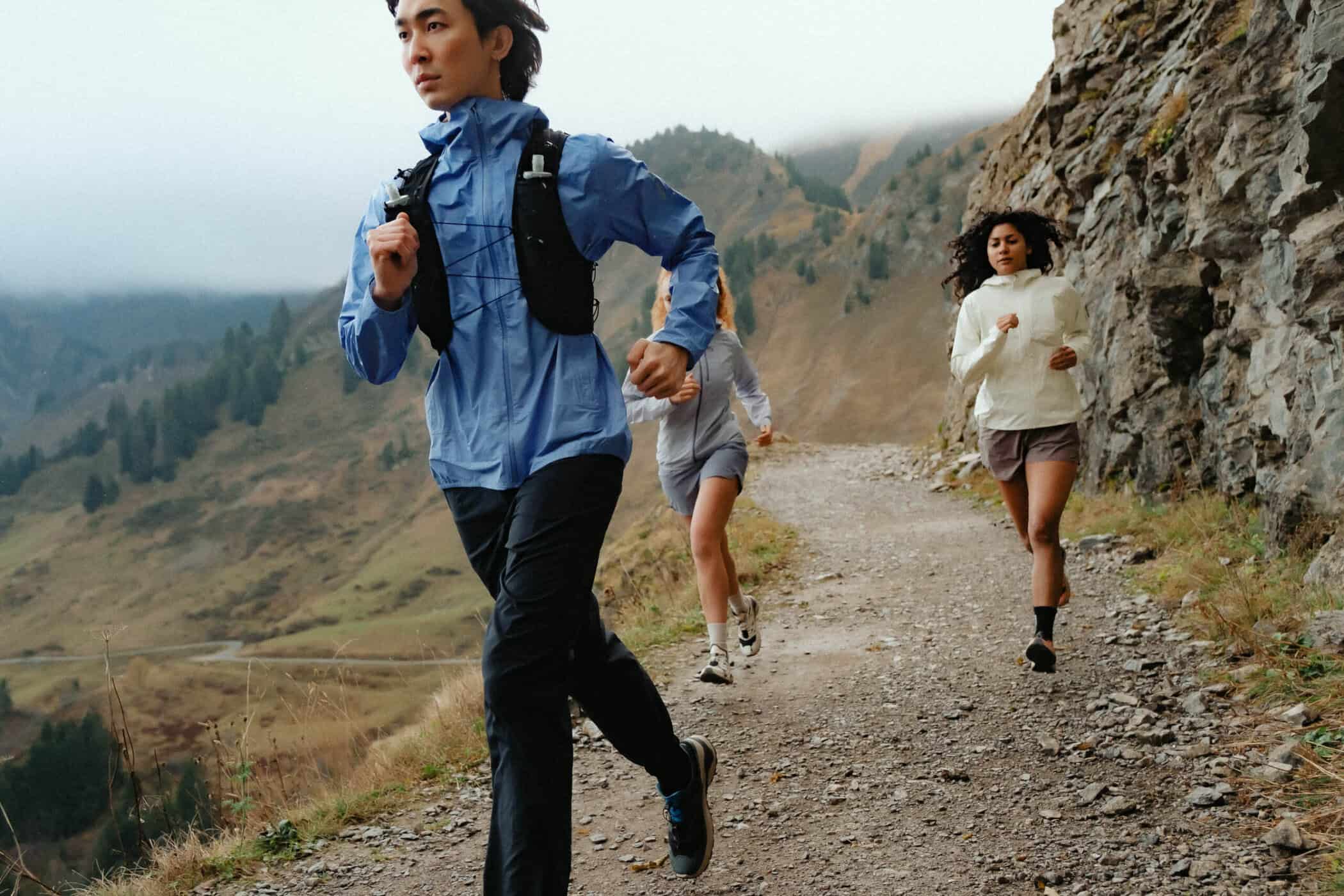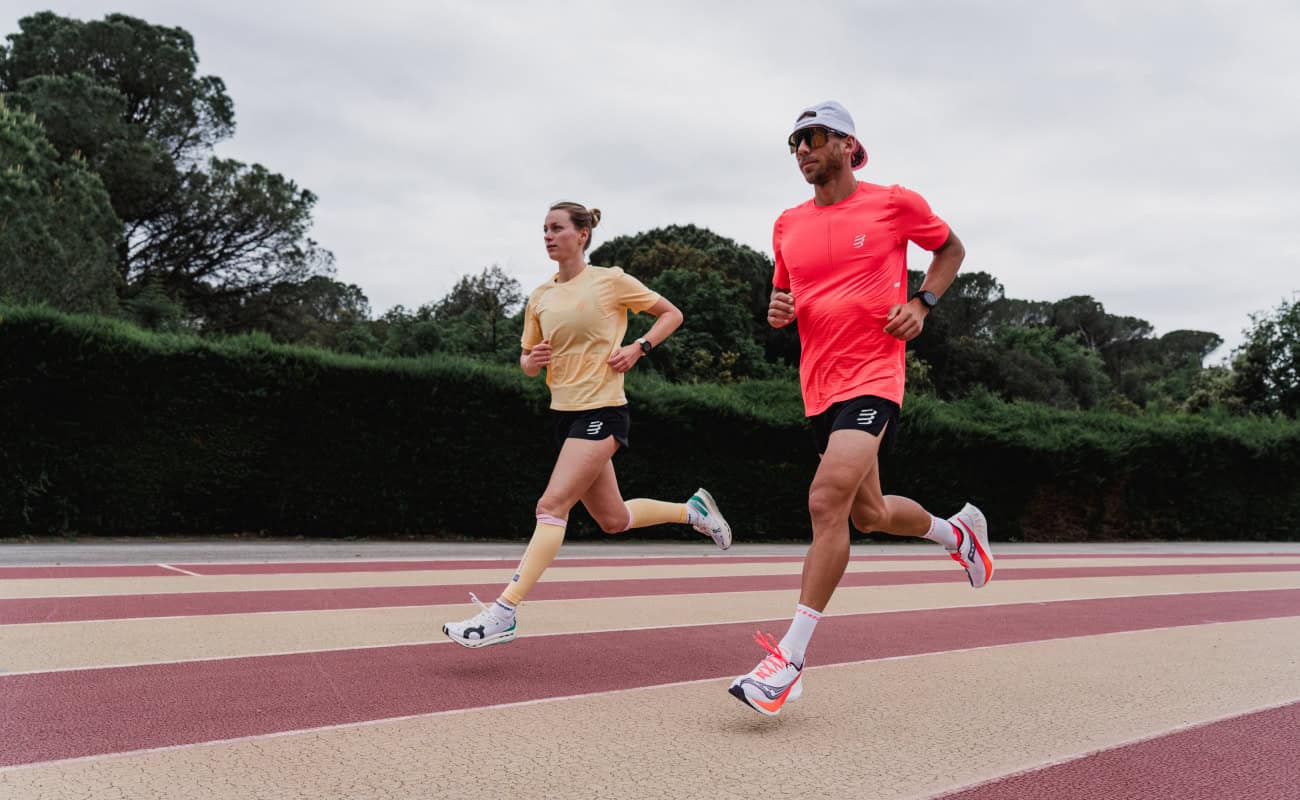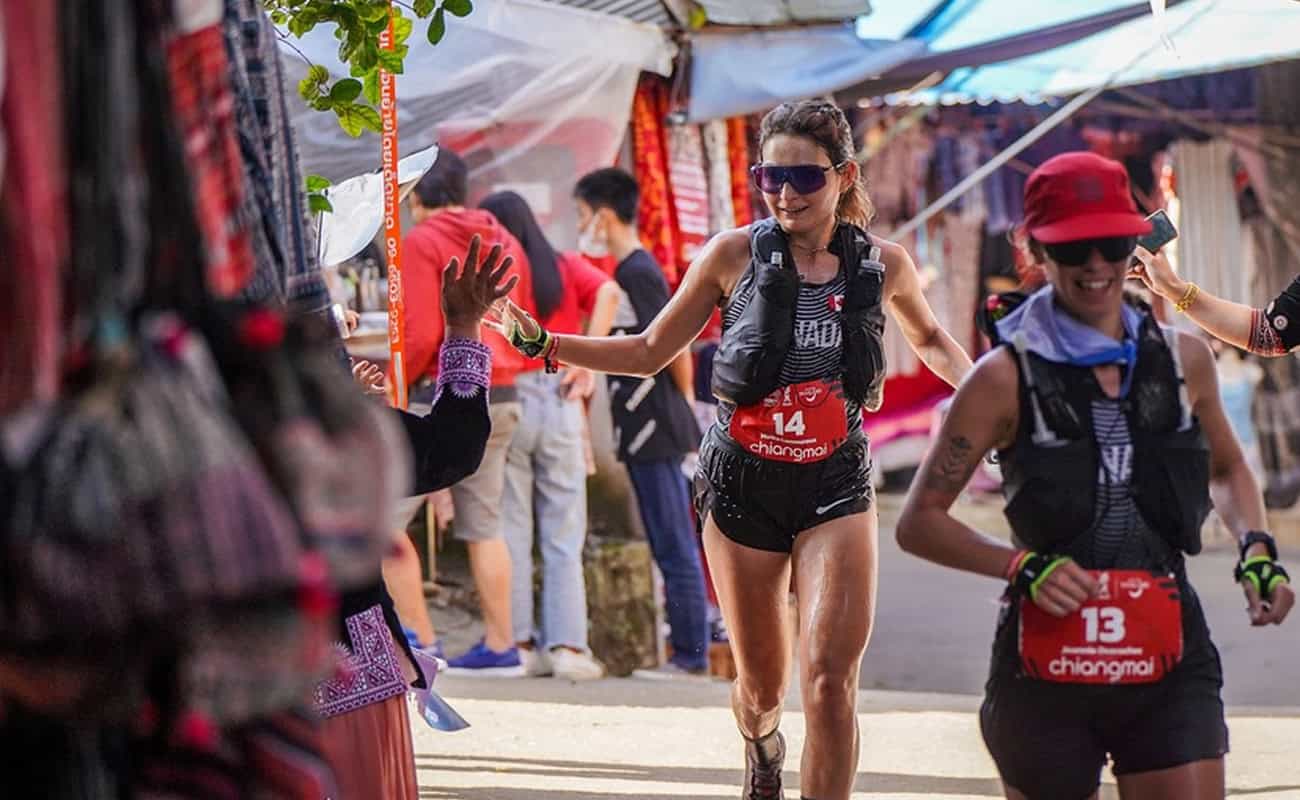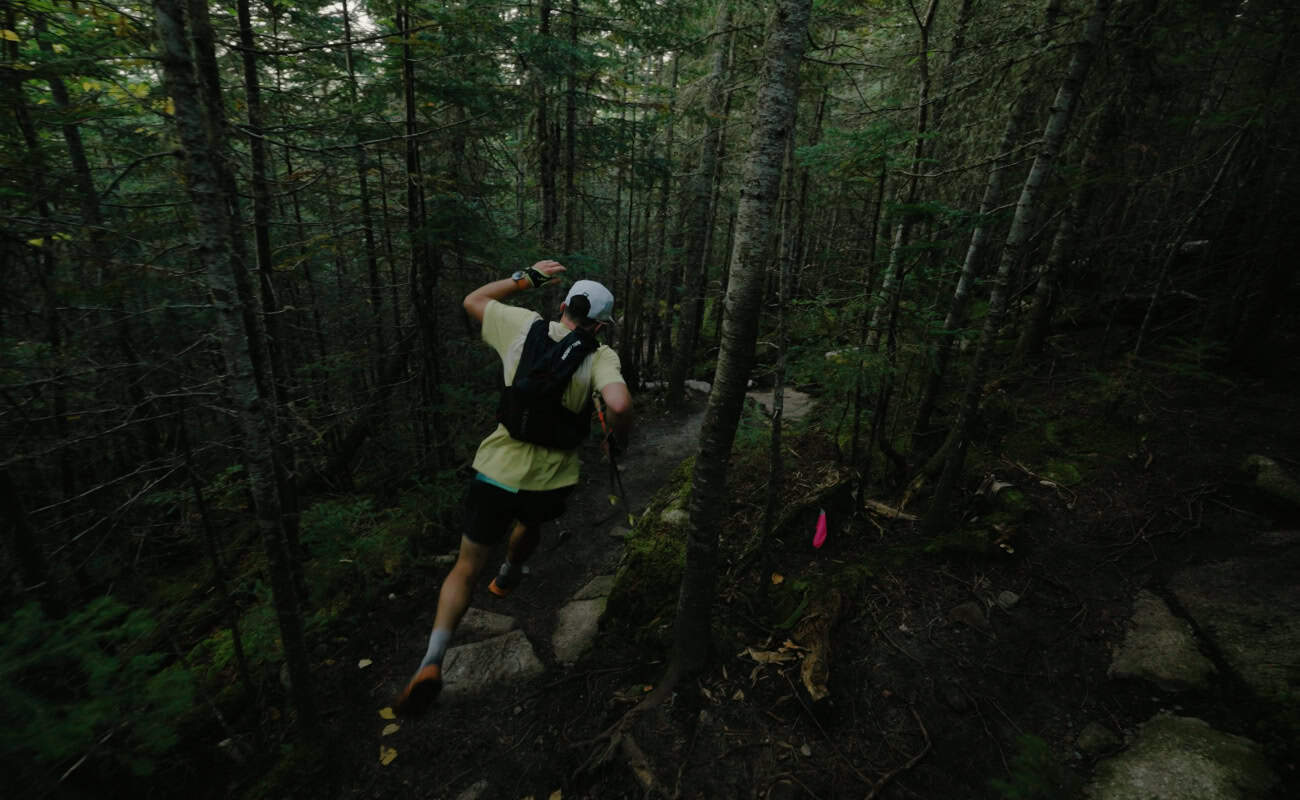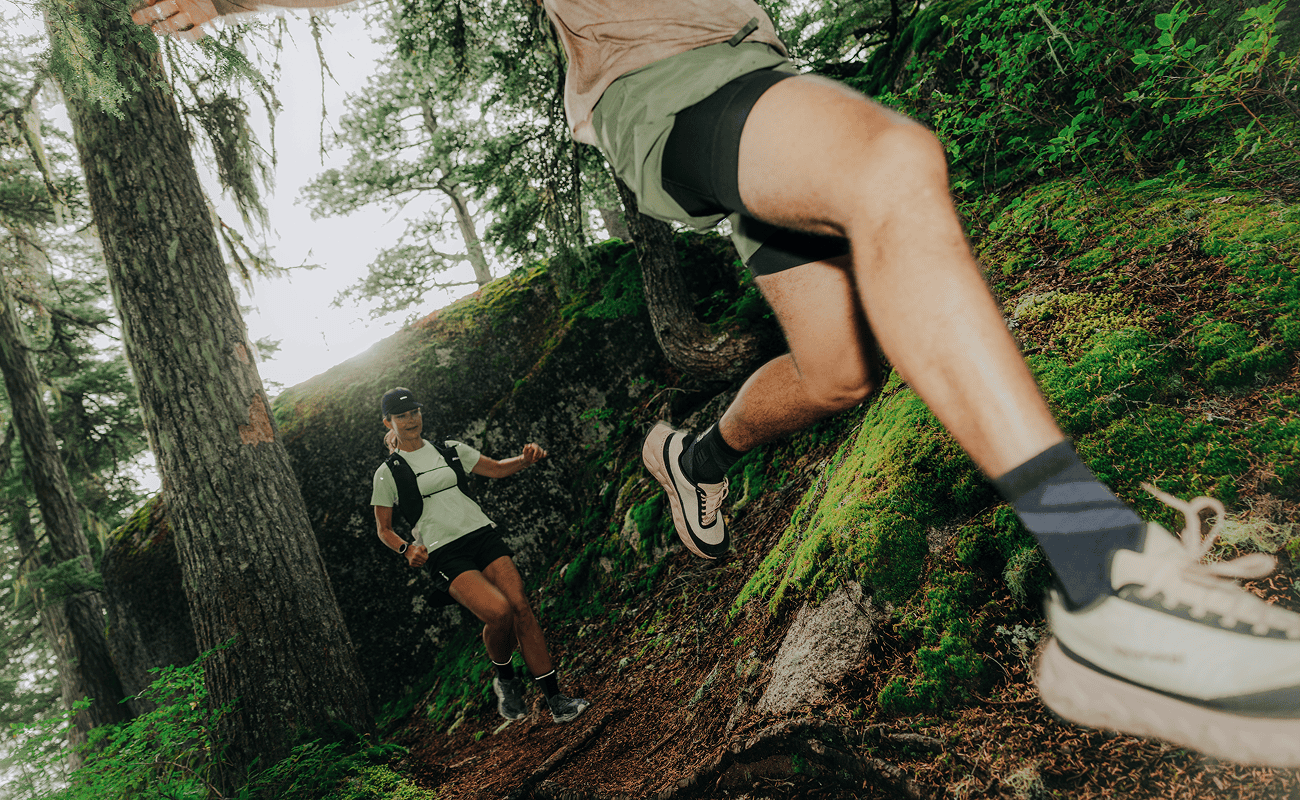It’s the day you’ve been training for for months. All those early morning runs and late evening sessions have been in preparation for this moment: race day. You’ve put in the work, and we want to help you put your best foot forward (literally).
Understanding Race Day Shoes
We often get questions like “Can I use trail shoes on the road?” and we wanted to take the time to answer properly. The criteria that go into choosing lightweight trail running shoes differ from those that go into selecting your footwear for a road race.
Running shoes for beginners will have the essentials, but the more you run, the more you’ll learn about your body and what works for you in terms of fit, comfort, and features. If you’re making the switch from pavement to trail, you’ll want to choose a running shoe adapted to the terrain.
Read more: Best Long-Distance Running Shoes
Road vs. Trail Shoes: Key Differences
Anyone who has run both a road race and a trail run will tell you they are two very different events, requiring different preparation, apparel, and, yes, shoes.
At first glance, the main difference you’ll notice is in the sole. Road shoes often feature a thick, cushioned sole designed for added responsiveness, usually referred to as a “rocker design” (think of a rocking chair). Trail running shoes will feature rubberized lugs for added grip, with less cushioning to ensure better contact with the terrain, and improved stability.
In terms of construction, a road race shoe typically features a lightweight mesh upper. In contrast, a trail runner has reinforced toes and overlays, which favour tighter weaves and weatherproof protection to prevent water and debris from entering the shoe. The build is reflected in the weight, with the road shoe being much lighter since it doesn’t require as much protection.
Why Proper Footwear Matters for Performance
At first glance, it might be overwhelming to browse through the long list of running shoes as a beginner. Searching “what are the best race day shoes for a marathon” is a good place to start, but there are so many factors to consider.
The slightest difference in the thickness and responsiveness of your outsole could mean shaving a few seconds off on race day. Having a better grip on the terrain can help avoid injuries. Race shoes will have fits and dimensions adapted to the discipline, which helps maximize the power of each step and improve overall performance.
Key Features to Look for in Race Day Shoes
If you’re preparing for a race day, take the time to conduct a proper running shoe comparison to determine which brand and model are best suited to your foot and the race terrain. When researching shoes, there are several key specifications to consider to ensure optimal performance.
Shop Men’s Shoes | Shop Women’s Shoes
Cushioned Shoes and Responsiveness
Long road races require shock absorption in the foot strike zone, and a good shoe will feature responsive foam midsoles, and in the case of the adidas Adizero Adios Pro 4, carbon-infused Energyrods 2.0, which provide energy return and instant turnover—a unique design feature to replace the often used carbon plates found in most running shoes.
The combination of midsole foam and carbon plates is designed to minimize muscle fatigue, enhance propulsion, and ensure consistency during long, flat races. Cushioning and responsiveness are the factors that most distinguish road from trail running shoes.
The design of a trail runner like Salomon’s S/Lab Pulsar 3 Trail Running Shoe finds the right balance between lightweight performance and trail-optimized features. On the trail, you want to ensure your shoe provides maximum traction, and the outsole of the S/Lab Pulsar 3 is made from an optimized rubber compound designed for mixed, muddy, and smooth terrains. These, like most trail runners, feature a stiffer midsole that will favour a more controlled footing. On the trails, the focus is less on bounce and more on protection and grip.
Fit and Support
The name of the game when it comes to road racing is speed and efficiency. The best marathon shoes are often designed with lightweight materials, such as mesh, and feature a snug overall fit and a tight toe box that ensures minimal movement inside the shoe.
The best running shoes for race day will have a visibly apparent rocker design, which provides stability when running in a straight line. Heel counters, the section of the shoe at the base of the heel, will be either semi-rigid or minimal to reduce the overall weight.
The Speedcross 6 is a classic trail runner that does everything right. It features a rigid heel counter for added stability. The lacing system is integrated into the overlays to ensure a snug fit with minimal movement inside the shoe. The Speedcross slips on like a sock and combines with a Gore-Tex membrane to ensure rocks, water, and debris stay out.
Price: 0.00$
Brand Name | Product Type
Brand Name | Product Type
The Speedcross 6 is a classic trail runner that does everything right. It features a rigid heel counter for added stability. The lacing system is integrated into the overlays to ensure a snug fit with minimal movement inside the shoe. The Speedcross slips on like a sock and combines with a Gore-Tex membrane to ensure rocks, water, and debris stay out.
Price: 0.00$
The structure and geometry of the best lightweight trail running shoes will focus on providing as much stability and support as possible. The trails are often unpredictable, with loose rocks, muddy patches, and uneven terrain providing challenges at every step.
Trail runners, unlike road shoes, will feature overlays and reinforced panels that add weight but provide much-needed protection against debris. Rough, solid terrain can lead to swelling, and to compensate for the more rigid structure of the shoe, trail runners will have a roomier toe box. In terms of support, trail runners will have reinforced heel counters for added stability during descents.
Weight and Speed
As we’ve already established, the design of each shoe is made to match the requirements of the terrain. The average marathon shoe will be lighter because it requires less structural support. The design is meant to help you do the work, with features like the rocker design and foam midsole propelling you forward. The heavier the running shoe, the more energy you expend. And on race day, you want to conserve as much energy as possible.
Speed is equally important on the trails, but how you make up those seconds is different. Rubber lugs add weight, but the added traction will help you maneuver tricky terrains. Midsoles on trail runners are more rigid, which limits the propulsion effect but provides a better feel for the ground and offers improved stability. Yes, trail shoes are heavier than road shoes, but the added weight is necessary.
Top Recommendations for Race Day Shoes (Road & Trail)
Now that we have a better understanding of the differences between road and trail shoes and how each can maximize your performance, we can move on to the fun part. To get you ready for race day, we’ve selected the best race day shoes of 2025 by category for easy browsing.
The Best Marathon Running Shoes
Feast your eyes on the top race day running shoes for the upcoming season. We start with Hoka’s Mach 6, a shoe designed for long-distance racing with superb cushioning and a lightweight feel. If you’re looking for a speed-focused design, the Brooks Hyperion Elite 5 runner features a woven upper and a DNA Flash midsole for maximum energy return.
New Balance brings its A-game with the FuelCell SC Elite v5, which combines a super-light FuelCell foam with a sleek design, making it perfect for race-day speeds. The Endorphin Pro 4 from Saucony, equipped with a carbon fibre plate, is designed for speed and endurance, making it ideal for road races. On brings the latest running technology to the Cloudrunner 2, resulting in an all-arounder designed for everything from 5Ks to Marathons, recovery runs, and training sessions.
Our top marathon running shoes
Best Race Day Trail Shoes
Moving on to the trail, we’ve got some top performers engineered to take on the most challenging trails. The Salomon S/LAB Ultra 3 is tailored for trail ultra distances, offering superior grip and comfort during varied terrain runs. Hoka’s Tecton X 3 is a beast of a shoe with outstanding traction and a gaiter-like extended knit collar for added protection against trail debris. The Mont Blanc is designed for long-distance ultramarathons on various terrains, featuring Altra‘s unique foot shape and cushioning.
Topo Athletic’s Ultraventure 4 offers plenty of stability over rugged trails while providing a foot-shaped toe box for maximum comfort. Rounding up our list is the adidas Terrex Agravic Speed Ultra, which features a dynamic rocker design for smooth & efficient forefoot running, with seamless overlays for durable protection on any terrain.
Our top trail running shoes
Innovative New Release for 2025
Brand Name | Product Type
Product Name
Price: 0.00$
Norda is a new player in the shoe game, but they bring years of experience and know-how to their 001A trail running shoe. Engineered in Montreal and designed to conquer the world's most challenging trails, this eco-friendly trail shoe delivers superior grip and breathability, showcasing innovation in sustainable outdoor gear.
Standout features:
- Seamless upper constructed from bio-based Dyneema for ultimate durability
- Vibram MegaGrip rubber compound for superior grip on all surfaces
- Norda Lock System provides a secure, non-slip fit
Price: 0.00$
User Scenarios and Testimonials
Success Stories from Real Runners
Here is what some of our clients had to say about our selection of race-day shoes for road and trail…
Hoka Mach 6 Road Running Shoes
Comfortable and very responsive
“Right out of the box, these felt great! No break-in period needed. Feels bouncy and very responsive. Can really pick up the pace or take it easy in these. Great all-around shoe. As for size, I am usually between an 8.5 and a 9. I got 8.5, and they are perfect.”
New Balance FuelCell SuperComp Elite v5 Running Shoes
Big improvement
“The V5s feel like a big improvement compared to the previous version. I love the significant reduction in weight and the race-day feel of this shoe, without sacrificing comfort. I’ve had issues with carbon shoes bothering my feet in the past, and the previous version solved that for me. I was nervous with so many changes that this version wouldn’t work for me, but that hasn’t been the case!”
Hoka Tecton X 3 Trail Running Shoes
Amazing long-distance race shoe
“This is my new favourite long-distance trail shoe for speedwork and long distances, especially for smooth to semi-technical terrain. The peba midsole is so comfortable and bouncy. The matrix upper is solid and secure. The outsole has plenty of traction for a variety of surfaces. I just raced Canyons 100k in these shoes, and they worked great. I personally found that they fit slightly small, so I went a half size up compared to the size I usually wear with Hokas.”
Altra Mont Blanc Speed Trail Running Shoes
Great technical trail shoe
“Previously had the Altra Olympus. These are a much lighter, less bulky feeling shoe. The toebox is narrower than the Olympus but still very roomy. The Vibram Megagrip is a must for me. All combine to create a nimble shoe built for rocky and rooty trails.”
Expert Insights: What Sets Apart the Best Running Shoes?
A standout road shoe will have all the fundamental design features that help maximize responsiveness, propulsion, and comfort. It will feel lightweight on your feet, and it’ll minimize the impact of every stride.
The best lightweight trail running shoes will provide maximum grip as you navigate the trails. You’ll feel the ground beneath your feet, but it won’t cause any pain. At the midfoot and heel, it will feel snug, but in the toe box, you’ll have the room to move your toes.
Contrary to running shoes, you won’t necessarily feel like you’re walking on a cloud, but you will feel like you can hop over obstacles and keep your footing on trickier terrain quickly. And for those who want to make a statement, you’ll find most brands offer a wide range of stylish colour combinations.
FAQ
How Should Race Day Shoes Fit?
Your road race shoe should feel like a second skin, with no overlays and a snug fit all around. When you’re running, your foot should be completely locked in with very little wiggle room in the toe box.
Your trail runners may feel heavier, relatively speaking, and you should have more room in the toe box. But at the midfoot and heel level, they should be locked in with minimal movement. In terms of sizing, leave a bit of space at the front to avoid toe bruising on descents.
Can I Use My Trail Shoes for Road Racing?
There’s a difference between can and should. If you want to wear big, bulky hiking boots during a road race, we won’t stop you. But if you plan on competing, you should wear your trail shoes on the trail and your road shoes on the road. For all the reasons mentioned above, each is designed with a specific discipline in mind, and wearing the proper footwear will ensure comfort, stability, and overall performance.
What is the Ideal Drop for Race Day Shoes?
When it comes to drop, there is minimal overlap between the average road shoe and the average trail shoe. A road shoe will typically have a larger drop, ranging from 8 to 10mm, to reduce calf strain and enhance speed and efficiency. The average trail runner will have a drop somewhere between 4 and 8mm to provide stability, balance, and a better feel for the ground. Some trail runners may even opt for a sub-4 mm drop on shorter, more technical trails to enhance agility.
Making Your Choice: Finding the Right Race Day Shoe
Some might argue that it’s not the shoe, but the runner who wins the race. That may be true, but any good runner will tell you the shoe makes a huge difference. Cushioning, fit, support, responsiveness, and weight are all important factors to consider. Whether you’re running a half-marathon, an ultramarathon, or a 5K trail, our wide selection of road running shoes and trail running footwear is sure to boost your performance on race day.


